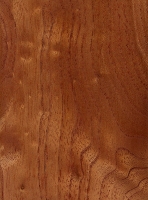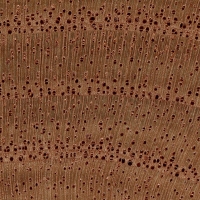 |
Common Name(s): Australian Red Cedar, Toona Scientific Name: Toona ciliata (syn. Cedrela toona) Distribution: Southern Asia and Australia Tree Size: 100-130 ft (30-40 m) tall, 3-5 ft (1-1.5 m) trunk diameter Average Dried Weight: 30 lbs/ft3 (485 kg/m3) Specific Gravity (Basic, 12% MC): .40, .49 Janka Hardness: 700 lbf (3,130 N) Modulus of Rupture: 10,370 lbf/in2 (71.5 MPa) Elastic Modulus: 1,336,000 lbf/in2 (9.22 GPa) Crushing Strength: 5,240 lbf/in2 (36.1 MPa) Shrinkage: Radial: 3.8%, Tangential: 6.3%, Volumetric: 10.8%, T/R Ratio: 1.7 |
Color/Appearance: Heartwood color ranges from pinkish to a darker reddish brown. Paler sapwood is clearly demarcated from heartwood.
Grain/Texture: Grain is generally straight to slightly interlocked, with a coarse, uneven texture. Good natural luster.
Endgrain: Semi-ring-porous; solitary and radial multiples; large to very large pores, sometimes forming single broken rows, very few; reddish-brown deposits occasionally present; parenchyma vasicentric, marginal; narrow to medium rays, spacing wide to normal.
Rot Resistance: Rated as moderately durable; moderate to poor insect resistance.
Workability: Easy to work with both hand and machine tools. Some difficulty can be encountered when surfacing quartersawn surfaces with interlocked grain. Can also exude resin and gum up cutters. Glues and finishes well.
Odor: Distinct, lingering, cedar-like scent when being worked.
Allergies/Toxicity: Although severe reactions are quite uncommon, Australian Red Cedar has been reported to cause skin and respiratory irritation, as well as other effects, such as asthma-like symptoms, migraine, giddiness, bronchitis, and stomach cramps. See the articles Wood Allergies and Toxicity and Wood Dust Safety for more information.
Pricing/Availability: Seldom exported, Australian Red Cedar is sometimes available as lumber, or as musical instrument tops. Prices are likely to be moderate for an imported hardwood.
Sustainability: This wood species is not listed in the CITES Appendices or on the IUCN Red List of Threatened Species.
Common Uses: Furniture, cabinetry, veneer, musical instruments (guitar tops), and boatbuilding.
Comments: Formerly placed in the Cedrela genus, Australian Red Cedar bears many similarities with Spanish Cedar (Cedrela odorata). Both species are in the Mahogany family (Meliaceae), and Australian Red Cedar is sometimes referred to as Indian Mahogany.
None available.








I grew up in Papua New Guinea and used to make clocks from this wood.It is beautiful with a satin poly applied. It will darken to a nice brown color – these clocks are about 25 years old.
I’ve heard that Australian red cedar doesn’t take oils well and irreversibly Stains the timer a dark brown/black, what’s the truth of this?
Can Australian Red Cedar be used as outdoor furniture, I have lots of big turned legs suitable for a table and some big 50 mm thick x 200 wide slabs for a table top (all from an old stair case, late 1800s ) . Just wondering how it would go outside.–any takers ?
Doug. I’d be inclined to make a fine dining table out of it, and keep it or sell it and get an outdoor setting of Teak or Iroko or Kwila (Merbau).They will last longer with better weathering ability than Aust Red Cedar…and then you could enjoy the natural beauty of Australia’s finest timber (IMHO)…just my 2 cents. Best to your project.
Jim Pearson, 3rd gen retired timber merchant and cabinetmaker